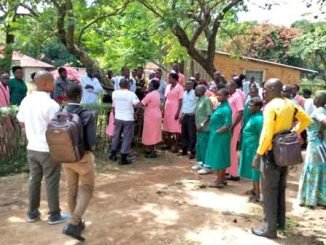
Kampala, Uganda | URN | There is a rise in HIV infection among older men according to health experts. Information from Uganda Aids Commission (UAC) shows that majority of men between 45 and 49 years of age who have been seeking for health services in the past years tested positive.
This according to health experts is worrying and likely to see an increase of the disease burden among the already 1.2 million adults out of the 1.4 million people living with HIV/AIDS in the country. Victor Rwengabo the Uganda Aids Commission zonal coordinator for Gulu notes that their finding indicates older men between 45 and 49 years of age are contracting HIV/AIDS compared to young men.
Young people (between 15-24 years) are responsible for 34% of new HIV infections annually. He notes that although they are yet to get concrete reasons for the new trend, he says the key factors among them is financial stability, long travels out of home and high sexual libido among men between 45 and 49 years of age.
According to Rwengabo, this is directly contributing to the high HIV/AIDS burden among young girls who target these men adding that it’s the reason the presidential fast-track initiative is focusing on men.
Dr. Hilary Alima, an HIV/AIDS specialist says men still have low health seeking behaviors in regards to understanding their HIV/AIDS status which he said also applies to young men. He however noted that the high HIV prevalence among older persons is perturbing saying it begs answers from the target group.
“The men, the boys and children are a gap and are not testing. We have actually found out of late that older men above 49 years-old are beginning to get HIV/AIDS infection. The data is very clear. We are trying to understand what could be the driving factor,” Dr. Halima said.
He says the index and partner testing where a person who has been diagnosed with HIV brings or identifies their sexual partner for voluntary HIV/Aids testing is positively helping in the fight against the scourge in the region. HIV/AIDS prevalence in mid north comprising of Lango and Acholi sub regions still stands at about 7.2 percent, higher than the national average of 6.2 per cent.
Dr. Michael Ochwo, an expert on HIV/Aids at The Aids Support Organization (TASO), says the high prevalence mostly among adults has now been compounded with the low response for treatment from corporates. He says many are dying silently fearing to be stigmatised while accessing some of the health facilities providing the life prolonging antiretroviral therapy while others are now purchasing drugs from Kampala or sharing with their spouses.
Dr. Ochwo explains that they launched an initiative last year that provides exclusive services to the corporate class in their comfort outside the normal times of treatment.
He says currently 64 corporate clients are receiving treatment through this arrangement which wouldn’t have been possible. At least 8,706 clients are currently enrolled on ART at Gulu TASO center. This is followed by Gulu Regional Referral Hospital with 6,000 clients and St. Mary’s hospital Lacor with 4,500 clients.
Read Also: Mayors’ Alliance proposes compulsory HIV/AIDs testing for Ugandan men
He however says that although such an initiative is helpful in ensuring that men of corporate class don’t miss out treatment, their efforts to scale it up are hampered by limited finance and stringent donor fund directives. Early this year, Kitgum district health officials revealed an increase in HIV/AIDS cases within Namokora, Orom and Lagoro sub counties, which stood at 3.8 per cent above the district rate of 3.4 per cent mostly among boys and men of 15-49 years old.
Kitgum district HIV/AIDS prevalence rate stands at 7.3 per cent, highest in Acholi sub region where some nearly 60,000 people are living with disease. Uganda still registers 1,000 new infections and 500 deaths every week, according to the Presidential Fast -Track Initiative on Ending HIV and AIDS in Uganda fact sheet released last year.



